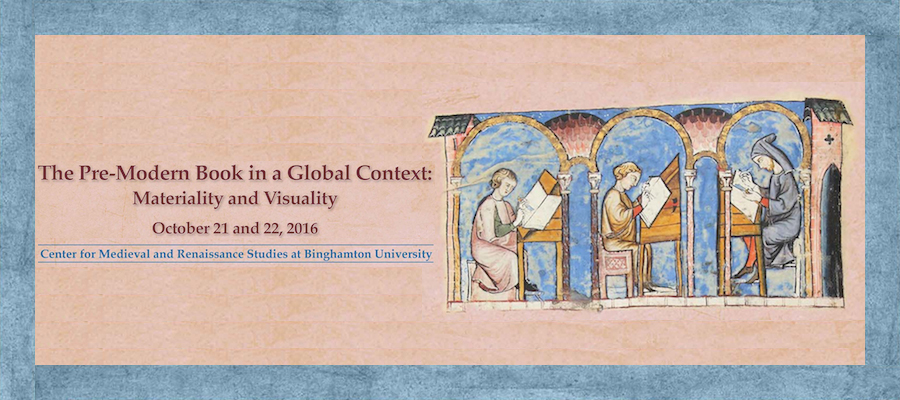The Pre-Modern Book in a Global Context: Materiality and Visuality, SUNY Binghamton, October 21–22, 2016
The year 2016 marks the fiftieth anniversary of the founding of the Center for Medieval and Renaissance Studies (CEMERS) at Binghamton University; in celebration of fifty years of research in Medieval and Early Modern Studies, CEMERS will host a conference on the materiality and visuality of the pre-modern book (from late antiquity until 1600).
The twenty-first century has witnessed the transformation of the study of the history of the book. Technology has given us new methods for the study of papyri, manuscripts and early printed books: every things from x-rays to DNA analysis now provides data regarding the production and use of the book in the pre-modern era. In addition, digital humanities now allows for the precise capture and reproduction of texts in all their visual specificity as well as the compilation of vast databases for “distinct reading.” Yet, as any scholar of the book recognizes, these artifacts retain an aura that technology cannot duplicate or fully explain: an encounter with a pre-modern book is an encounter with a textual presence in all its ineffable alterity. The materiality of books is central to a consummate experience of a test, and this quality of ancient, medieval, or early modern textual artifacts is not reproduced even in the most spectacular digital simulacra.
Papers are invited on the materiality and visuality of the book as artifact in a global context. This conference aims to bring together the sub-disciplines currently involved in the history of the book in order to facilitate interdisciplinary dialogue. Papers and sessions that synthetically address the current state of the field are especially welcome.
Topics may include:
- The study of the production and circulation of books in the Mediterranean basin and across the Eurasian landmass
- Codicology and the making of books
- Paleography and textual transmission
- The transitions from papyrus to parchment and the scroll to codex
- The current state of technological analysis
- Visual culture and book illumination
- The book as commodity
- Network theory and the itineraries of textual artifacts
- Geographical locations for the use of paper
- The origins of moveable type and the itinerary of the printing press
- The transitions from script to print
- The uses of paper in specific book culture
- The use of wax tablets
- The history of libraries
- The history of scriptoria
- The transmission of non-textual information (music, maps, etc.) in books
Proposals for sessions are also invited.
